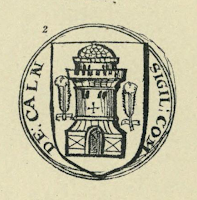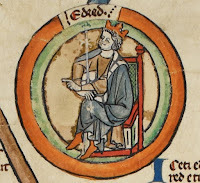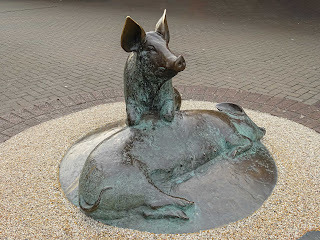Calne Curiosities: Exploring Calne's History and How We Say the Name
 Arms of the Guild and Stewards of Calne,
Arms of the Guild and Stewards of Calne, from The Visitation of Wiltshire 1623.Having lived in Wiltshire for close to two decades, I'vecome to appreciate the often-surprising ways local place names are pronounced.Let's explore a fundamental part of Calne's fabric: the town's name itself –its ancient roots, its historical spellings, and the ongoing discussion aroundhow we say it today.
Our earliest written record of Calne dates to the 10thcentury, specifically the Will of the Saxon King Edred (c. 923 – 955), grandsonof Alfred the Great. In this document from 955, King Edred bequeathed theestates of Downton, Damerham, and Calne to the Old Minster at Winchester,indicating Calne's royal ownership and significance even in those early times.
 Saxon King EdredYet, the name "Calne" is even older than thisfirst written mention. Linguistic analysis suggests a pre-English origin, with ADictionary of British Place Names confirming its antiquity. One leadingtheory, supported by the linguist Ekblom (1917), points to a Celtic origin,potentially linking it to "Colne" in Lancashire, a name that itselfwas once recorded as "Calna" – a spelling also used for Calne in1091. The prevailing explanation connects "Calne" to the river of thesame name, derived from the Celtic "Col-aun," meaning "meetingor current of waters," likely referring to the confluence of streamsfeeding the River Marden and Abberd Brook in the town's heart. Intriguingly,the Norman scribes of the Domesday Book in 1086 referred to the town as"Cauna" or "Caune," further solidifying the earlyestablishment of the name.
Saxon King EdredYet, the name "Calne" is even older than thisfirst written mention. Linguistic analysis suggests a pre-English origin, with ADictionary of British Place Names confirming its antiquity. One leadingtheory, supported by the linguist Ekblom (1917), points to a Celtic origin,potentially linking it to "Colne" in Lancashire, a name that itselfwas once recorded as "Calna" – a spelling also used for Calne in1091. The prevailing explanation connects "Calne" to the river of thesame name, derived from the Celtic "Col-aun," meaning "meetingor current of waters," likely referring to the confluence of streamsfeeding the River Marden and Abberd Brook in the town's heart. Intriguingly,the Norman scribes of the Domesday Book in 1086 referred to the town as"Cauna" or "Caune," further solidifying the earlyestablishment of the name.The Evolving Written Form of Calne
Like many place names (and indeed, surnames), the spellingof Calne has been far from static over the centuries. Within Wiltshire alone,we see examples like Cherhill (once "Ciriel" and"Chirieli") and Yatesbury (formerly "Getesbir") undergoingsignificant transformations in their written forms. Even places like East andWest Kennett have seen a return to older spellings.
Drawing upon The Place Names of Wiltshire by Gover,Mawer, and Stenton, we can trace at least ten documented variations in thespelling of Calne since its first written appearance. It's crucial to rememberthat this record only captures spellings that were written down, survived thepassage of time, and have since been discovered; the spoken variations may havebeen even more numerous.
Here is a timeline of the documented spellings of Calne:
Variant
Earliest Date
Source
Calne
955
Cartularium Saxonicum, ed. W. de Gray Birch
æt Cálne
978
Anglo Saxon Chronicle
et Calnæ
997
Codex Diplomaticus Aevi Saxonici, ed. J. M. Kemble
Cauna, Caune
1086
Domesday Book
Calna
1091
Vetus registrum Sarisberiense alias dictum Registrum S. Osmundi, Episcopi
Kalne
1158
Report on Manuscripts in Various Collections (Historical Manuscripts Commission)
Calne
1198
Placitorum Abbrevatio (Record Commission)
Kaune
1236
Calendar of Close Rolls Preserved in the Public Record Office
Calle al. Calne
1460
Calendar of Patent Rolls (Public Record Office)
Cawne
1556
Feet of Fines, 1273-1760 (unpublished) in the Public Record Office
Cawen
t. Eliz (1558-1603)
Calendar of Proceedings in Chancery in the Reign of Queen Elizabeth, ed. J. Bayley
Caln
1588
Wiltshire Notes and Queries
Cawlne
1588
MS Collections of John Sadler in Wiltshire Museum at Devizes
Cane
1672
Admission to the College of St John the Evangelist
Caln and Calne
1753
Britannia Depicta road atlas
This historical overview reveals a fascinating trend: while the spelling ofCalne has indeed fluctuated, there's a strong tendency to revert to the"Calne" form. Considering its over 1000 years of written history, thecore spelling has shown remarkable resilience. The 16th century stands out witha cluster of variations like "Cawne," "Cawen,""Caln," and "Cawlne," even appearing concurrently. Thesubsequent standardization of English spelling likely cemented"Calne" as the dominant written form, although it's intriguing tonote that our Town Twin in Pennsylvania still uses the "Caln"variant, perhaps echoing one of these earlier spellings.
An Ancient Settlement and a Site of Significance
The long history suggested by the name's origins andspelling is further confirmed by archaeological evidence. Excavations inCastlefields in 2010 unearthed artifacts from the Iron Age, Roman, Saxon, andMedieval periods, firmly establishing Calne as a very ancient settlement. Itshistorical significance is also highlighted by the Anglo-Saxon Chronicle'srecord of a crucial meeting of the Witan, the King's chief advisors, held inCalne in 978.
From Wool to Bacon: Shaping Calne's Identity
 'Two Pigs' sculpture in Calne: A tribute to the town's historic bacon industry.
'Two Pigs' sculpture in Calne: A tribute to the town's historic bacon industry.Over the centuries, Calne's fortunes have been shaped byvarious industries and events. From the 12th to the 19th centuries, the woollenindustry brought considerable prosperity, leaving its mark on many of thetown's older buildings around The Green. However, the decline of this industryin the early 1800s brought hardship. An unexpected resurgence came with therise of the Harris family and their revolutionary bacon curing methods, establishedby the purchase of weak Irish pigs that would not survive their journey toLondon from their overnight stop Black Dog Hill. The Harris business grew todominate Calne both economically and physically in the 20th century,unfortunately leading to the demolition of some historic buildings for factoryexpansion. Other notable industries included the Maundrell Foundry, whichsupported the Harris operations.
Notable Figures and Lasting Legacies
Calne has also been associated with prominent figuresthroughout history. The 5th Marquess of Lansdowne of nearby Bowood House playeda significant role in national politics, while middle-distance runner WalterGoodall George, also from Calne, held the world mile record for over threedecades. The town was also the rectory of Edmund Rich, who later becameArchbishop of Canterbury and was canonized. Briefly, John Pym, a key figureleading up to the English Civil War, served as the town's MP.
Nearby Bowood House was a hub of scientific discovery, with Jan Ingenhousz,polymath and discoverer of photosynthesis a friend and guest, along with JosephPriestley's identification of oxygen taking place at the Grade I listedGeorgian country house surrounded by the landscaped parkland designed byCapability Brown . Priestley also conducted experiments at the Old Vicarage inMill Street, Calne, where he lived for a time. The impressive St. Mary's Churchstands as a legacy of the medieval wealth generated by the woollen trade.
Connecting with the World: Canal, Railway, andRegeneration
Calne's connections to the wider world evolved with theextension of the Wilts and Berks Canal in 1802 and the arrival of the CalneBranch Railway in 1863. While the canal eventually closed, the railway too fellvictim to the Beeching cuts in 1965. More recently, the closure of C&THarris in 1982 and the subsequent demolition of their factory buildings havepaved the way for the regeneration of the town, particularly along the RiverMarden and Beach Terrace.
The Ongoing Question of Pronunciation
 Given this rich and evolving history, and as the varyinghistorical spellings subtly suggest, the pronunciation of Calne remains a pointof local interest. Research into written sources reveals several possibilities: Canon Jackson, in his 1888 history, noted the contemporary pronunciation as "Calne (Carn)". The Pronunciation of 10,000 Proper Names (1909) suggested "kôn," which corresponds with a pronunciation of ‘Kawn’. The Place-Names of Wiltshire (1939) recorded the local pronunciation phonetically as "Kɑːn, vulgo (commonly known as) Kan," aligning with 'Kahn'.
Given this rich and evolving history, and as the varyinghistorical spellings subtly suggest, the pronunciation of Calne remains a pointof local interest. Research into written sources reveals several possibilities: Canon Jackson, in his 1888 history, noted the contemporary pronunciation as "Calne (Carn)". The Pronunciation of 10,000 Proper Names (1909) suggested "kôn," which corresponds with a pronunciation of ‘Kawn’. The Place-Names of Wiltshire (1939) recorded the local pronunciation phonetically as "Kɑːn, vulgo (commonly known as) Kan," aligning with 'Kahn'.My own experience living here suggests the most commonpronunciations are "Karn" and "Caln", with the emphasis onthe ‘l’, with "Calen" being less frequent in the UK but used by ourfriends in Caln Township. It's fascinating to observe how attached people areto their preferred pronunciation, often citing long family histories in thearea.
Whatever your perspective, it can be seen that from its royal connections inSaxon times and its significance as a meeting place of the Witan, through theprosperity of the wool trade and the transformative era of the Harris baconindustry, Calne has continually adapted and evolved.
The very name of the town, with its ancient Celtic roots and its variedspellings across centuries, serves as a tangible link to this enduring past.
Today, as residents and newcomers alike navigate the subtle nuances of itspronunciation, they become part of this ongoing story. Calne's identity is notfixed but rather a tapestry woven from its ancient heritage, its periods ofindustry and innovation, and the collective memory of its people – a town thatrespects its deep roots while embracing the present.
In the end, perhaps the most important aspect is mutual understanding. While wemight all have our preferred way of saying "Calne," the fact that werecognize the town being referred to speaks to the dynamic and accommodatingnature of language and of the wonderful people that live in this historic town.



